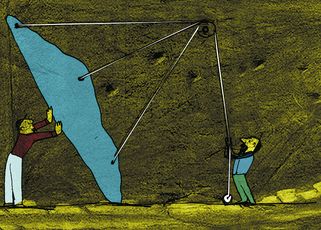Around this time in 2005, New Orleans on the Gulf Coast of the United States was struck by Hurricane Katrina. The devastation inflicted on the southern American city then, and now on Kerala by floods caused by the relentless monsoon rains is similar. The reaction of the respective national governments—George W. Bush was the US president then—to the death and destruction is also sadly similar. There have been complaints of apathy and even of not encouraging support coming in from outside. Of course, there is a lot of work to be done in the next few months in Kerala’s case, and one hopes that the Central government plays its part and helps the people in putting their lives back together.
The jury is still out on how much of the disaster could have been averted through better land and construction practices, environmental zoning and more efficient on-ground coordination. These are important reflections that must be undertaken. However, this must not be reduced to bickering. As the chief minister of Kerala rightly said, we should concentrate all our attention, energy and faculties on rebuilding Kerala.
There are many ways to do this. As we embark on the Herculean task of reconstructing our houses, roads, bridges and schools, we should bear some basic points in mind. We should remember that it is not just a brick-and-mortar process. It also involves long-term planning, efficient and sustainable building ideas and innovative material sourcing. I think the rebuilding must make use of the ideas and skills of architects and post-disaster reconstruction experts. In the present urgency, we must not make the mistake of amplifying the devastation by building difficult and unseemly infrastructure that ultimately reduces the quality of life. Kerala must answer the crisis by becoming stronger, healthier and more beautiful.
The typical aesthetics of the landscape must be taken care of. I have said this on this column before and I am repeating it. We should look for eco-friendly materials as well as designs. Building regulations, especially near river banks, have been flouted with impunity. When we rebuild, these regulations must be respected. Better architectural and design practices are not luxuries, and could actually reduce the financial burden of reconstruction.
There are examples that we can learn from. Look at how Fukushima and the neighbouring area rebuilt itself after it was struck by the tsunami. I began with New Orleans for a reason. The city bore the brunt of the damage when the levees failed, submerging 80 per cent of the city. I am not ignoring the lives lost and the trauma that was caused in 2005, but New Orleans is a vastly-improved place now. The reassembly of the city’s infrastructure was thoughtful and multilayered. High school graduation rates have jumped from 56 per cent before the storm to 73 per cent today, thanks to a proliferation of charter schools. There are more and higher-paying jobs than before Katrina, and the city is safer from floods thanks to a massive hurricane and flood protection system. An influx of the millennials post-Katrina delivered a stream of educated professionals to the city, flush with new ideas and energy. The infrastructure has got such impetus that tourism, which, like in Kerala, is the mainstay, is now much improved. New Orleans is one of the greatest comeback stories in American history. Kerala, too, can become a symbol of resurrection in India’s history.
editor@theweek.in


